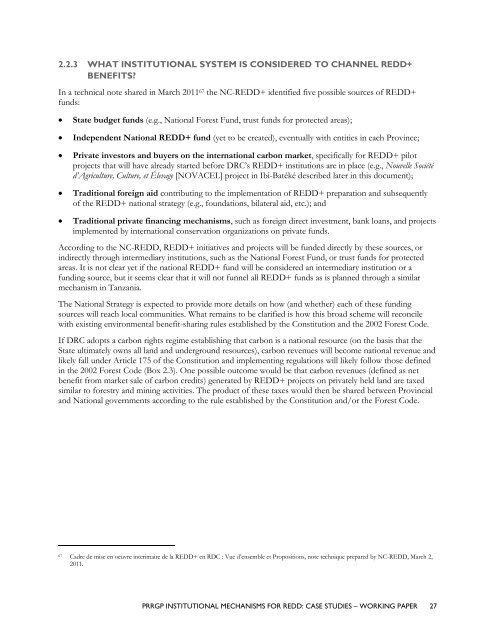Institutional Mechanisms for REDD+ - Case Studies Working Paper
Institutional Mechanisms for REDD+ - Case Studies Working Paper
Institutional Mechanisms for REDD+ - Case Studies Working Paper
You also want an ePaper? Increase the reach of your titles
YUMPU automatically turns print PDFs into web optimized ePapers that Google loves.
2.2.3 WHAT INSTITUTIONAL SYSTEM IS CONSIDERED TO CHANNEL <strong>REDD+</strong><br />
BENEFITS?<br />
In a technical note shared in March 2011 67 the NC-<strong>REDD+</strong> identified five possible sources of <strong>REDD+</strong><br />
funds:<br />
� State budget funds (e.g., National Forest Fund, trust funds <strong>for</strong> protected areas);<br />
� Independent National <strong>REDD+</strong> fund (yet to be created), eventually with entities in each Province;<br />
� Private investors and buyers on the international carbon market, specifically <strong>for</strong> <strong>REDD+</strong> pilot<br />
projects that will have already started be<strong>for</strong>e DRC‘s <strong>REDD+</strong> institutions are in place (e.g., Nouvelle Société<br />
d’Agriculture, Culture, et Élevage [NOVACEL] project in Ibi-Batéké described later in this document);<br />
� Traditional <strong>for</strong>eign aid contributing to the implementation of <strong>REDD+</strong> preparation and subsequently<br />
of the <strong>REDD+</strong> national strategy (e.g., foundations, bilateral aid, etc.); and<br />
� Traditional private financing mechanisms, such as <strong>for</strong>eign direct investment, bank loans, and projects<br />
implemented by international conservation organizations on private funds.<br />
According to the NC-REDD, <strong>REDD+</strong> initiatives and projects will be funded directly by these sources, or<br />
indirectly through intermediary institutions, such as the National Forest Fund, or trust funds <strong>for</strong> protected<br />
areas. It is not clear yet if the national <strong>REDD+</strong> fund will be considered an intermediary institution or a<br />
funding source, but it seems clear that it will not funnel all <strong>REDD+</strong> funds as is planned through a similar<br />
mechanism in Tanzania.<br />
The National Strategy is expected to provide more details on how (and whether) each of these funding<br />
sources will reach local communities. What remains to be clarified is how this broad scheme will reconcile<br />
with existing environmental benefit-sharing rules established by the Constitution and the 2002 Forest Code.<br />
If DRC adopts a carbon rights regime establishing that carbon is a national resource (on the basis that the<br />
State ultimately owns all land and underground resources), carbon revenues will become national revenue and<br />
likely fall under Article 175 of the Constitution and implementing regulations will likely follow those defined<br />
in the 2002 Forest Code (Box 2.3). One possible outcome would be that carbon revenues (defined as net<br />
benefit from market sale of carbon credits) generated by <strong>REDD+</strong> projects on privately held land are taxed<br />
similar to <strong>for</strong>estry and mining activities. The product of these taxes would then be shared between Provincial<br />
and National governments according to the rule established by the Constitution and/or the Forest Code.<br />
67 Cadre de mise en oeuvre interimaire de la <strong>REDD+</strong> en RDC : Vue d‘ensemble et Propositions, note technique prepared by NC-REDD, March 2,<br />
2011.<br />
PRRGP INSTITUTIONAL MECHANISMS FOR REDD: CASE STUDIES – WORKING PAPER 27

















